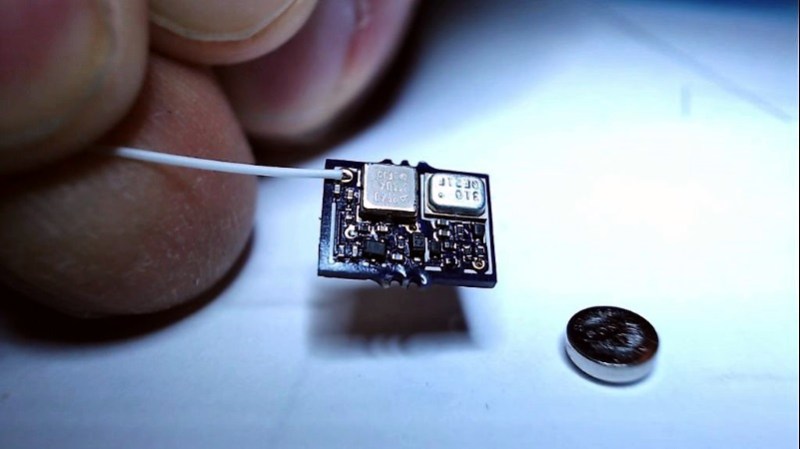When it comes to surveillance, why let the government have all the fun? This tiny spy transmitter is just the thing you need to jumpstart your recreational espionage efforts.
We kid, of course — you’ll want to stay within the law of the land if you choose to build [TomTechTod]’s diminutive transmitter. Barely bigger than the 337 button cell that powers it, the scrap of PCB packs a fair number of surface mount components, most in 0201 packages. Even so, the transmitter is a simple design, with a two transistor audio stage amplifying the signal from the MEMS microphone and feeding an oscillator that uses a surface acoustic wave (SAW) resonator for stability. The bug is tuned for the 433-MHz low-power devices band, and from the video below, it appears to have decent range with the random wire antenna — maybe 50 meters. [TomTechTod] has all the build files posted, including Gerbers and a BOM with Digikey part numbers, so it should be easy to make one for your fieldcraft kit.
If you want to dive deeper into the world of electronic espionage, boy, have we got you covered. Here’s a primer on microphone bugs, a history of spy radios, or how backscatter was used to bug an embassy.















“When it comes to surveillance, why let the government have all the fun? This tiny spy transmitter is just the thing you need to jumpstart your recreational espionage efforts.”
Hermits need not apply.
Challenge: Choose a random person and tail them for 24 hours (Might need a friend to help)(The friend might be a lawyer)
“so it should be easy to make one for your fieldcraft kit”, and then you rember the 0201 packages (0.25 mm × 0.125 mm)… Handling grains of dust and solder them reliably is probably not for everyone. Me personally, i don’t mind soldering tiny stuff. Could be an interesting training piece and challenge for our electronics technician apprentices.
You could hide a fair few in your prison pocket
Somebody has seen Deadpool 2
correction-its prison wallet not prison pocket
Yeah… noone interested in this wants to SEEM at all so. ????
…you mean my drawer-ful of fussy unstable commercial-FM-band bugs is now obsolete?
This is a good choice to get sensor feed back for a hobby project. Just use the mems sensor instead of mic.
I wonder why there is lots of ip-cams out there, but no ip-microphones in the market.